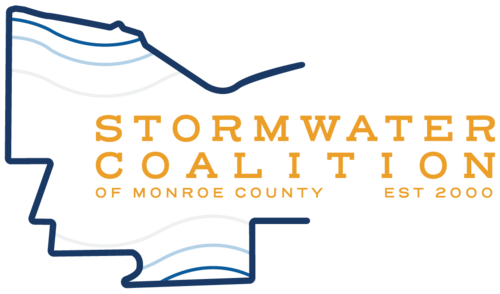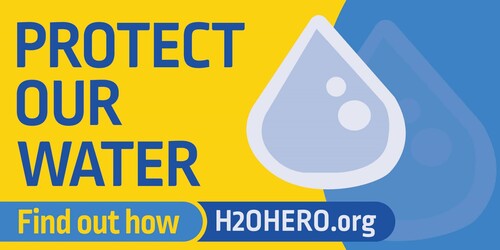Stormwater Management
What is stormwater?
Stormwater runoff carries pollutants into waterbodies
Stormwater is water from rain or melting snow that doesn't soak into the ground but runs off into waterways. It flows from rooftops, over paved areas and bare soil, and through sloped lawns while picking up a variety of materials on its way. The quality of runoff is affected by a variety of factors and depends on the season, local meteorology, geography, and land use.
What's the Problem
As it flows, stormwater runoff collects and transports pollutants to surface waters. Although the amount of pollutants from a single residential, commercial, industrial, or construction site may seem unimportant, the combined concentrations of contaminants threaten our lakes, rivers, wetlands, and other waterbodies. Pollution conveyed by stormwater degrades the quality of drinking water, damages fisheries and habitat of plants and animals that depend on clean water for survival. Pollutants carried by stormwater can also affect recreational uses of waterbodies by making them unsafe for wading, swimming, boating and fishing. According to an inventory conducted by the United States Environmental Protection Agency (USEPA), half of the impaired waterways are affected by urban/suburban and construction sources of stormwater runoff.
Examples of Pollution in Stormwater
- Nutrients such as phosphorus and nitrogen can promote the overgrowth of algae, deplete oxygen in the waterway, and be harmful to other aquatic life.
- Bacteria from animal wastes and illicit connections to sewerage systems can make nearby lakes and bays unsafe for wading, swimming, and the propagation of edible shellfish.
- Oil and grease from spills during vehicle maintenance activities causes sheen and odor and makes transfer of oxygen difficult for aquatic organisms.
- Sediment from construction activities clouds waterways and interferes with the habitat of living things that depend upon those waters.
- Careless application of pesticides, herbicides, and fertilizers affect the health of living organisms and cause ecosystem imbalances.
- Trash and debris damages aquatic life, introduces chemical pollution, and diminishes the beauty of our waterways.
What can be done?
Significant improvements have been achieved in controlling pollutants that are discharged from sewage and wastewater treatment plants. Across the nation, attention is being shifted to potential sources of pollution, such as polluted stormwater runoff, that are not normally treated by wastewater treatment plants. Stormwater management, especially in urban areas, is becoming a necessary step in seeking further reductions in pollution in our waterways.
The best way to control contamination to stormwater is usually at the source, where the contaminants can be identified, reduced, or contained before being conveyed to surface water. More often than not, it's more expensive and difficult to remove the combination of contaminants that are present at the end-of-pipe where stormwater is finally discharged directly to a receiving waterbody. Sometimes, significant improvements can be made by employing best management practices (BMPs). Proper storage of chemicals, good housekeeping, and just plain paying attention to what's happening during runoff events can lead to relatively inexpensive ways of preventing pollutants from getting into the runoff and our waterways.
The County (RPWD) has developed a Stormwater Management Plan to address these minimum control measures and summarizes its activities each year in a Monroe County Stormwater Coalition Shared Annual Report (click here for the page that contains the report). The annual report also includes stormwater management plans for the coming year. You are encouraged to read the annual report and send your written comments to the department.
The RPWD is a member of the Stormwater Coalition of Monroe County. The function of the Coalition is for permitted municipalities within Monroe County to work together toward the common cause of improving stormwater quality in a cost-effective and efficient manner.
What is an Illicit Discharge
Federal regulations define an illicit discharge as “...any discharge to an municipal sewer that is not composed entirely of stormwater...” with some exceptions. These exceptions include discharges from permitted industrial sources and discharges from fire-fighting activities. Illicit discharges are considered “illicit” because municipalities are not designed to accept, process, or discharge such non-stormwater wastes.
Sources of Illicit Discharges
-
Sanitary wastewater
-
Effluent from septic tanks
-
Car wash wastewaters
-
Improper oil disposal
-
Radiator flushing disposal
-
Laundry wastewaters
-
Spills from roadway accidents
-
Improper disposal of auto and
-
Household toxins
How to report an Illicit Discharge
Step 1: Observe from a safe distance. DO NOT touch or smell the substance.
Step 2: Notify
Weekdays between 8am-5pm please call the your municipal Public Works Department
In case of emergency call 911
Step 3: Provide information the following information
-
your name
-
phone number
-
discovery/incident time, date, and location
-
description of material, source if known
-
estimate extent of problem (slow trickle vs significant flow)
The sooner we learn about these incidents, the better our chance of finding the source and correcting the problem!
Call 753-7600 to Report an Illicit Discharge
















